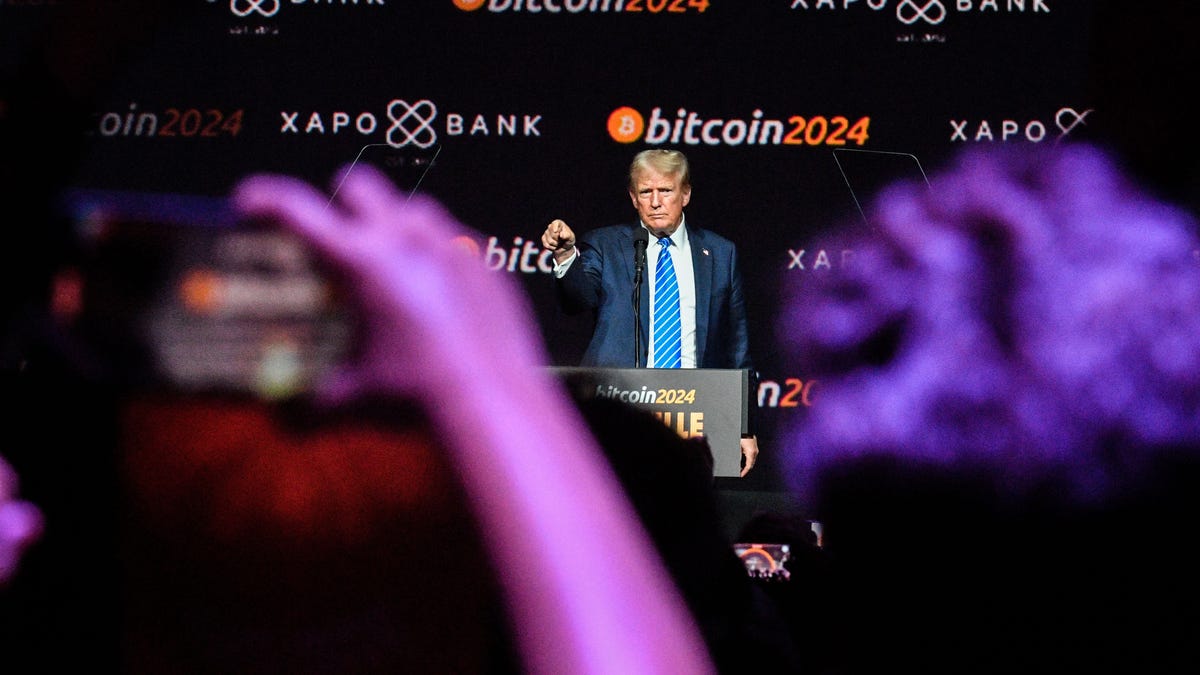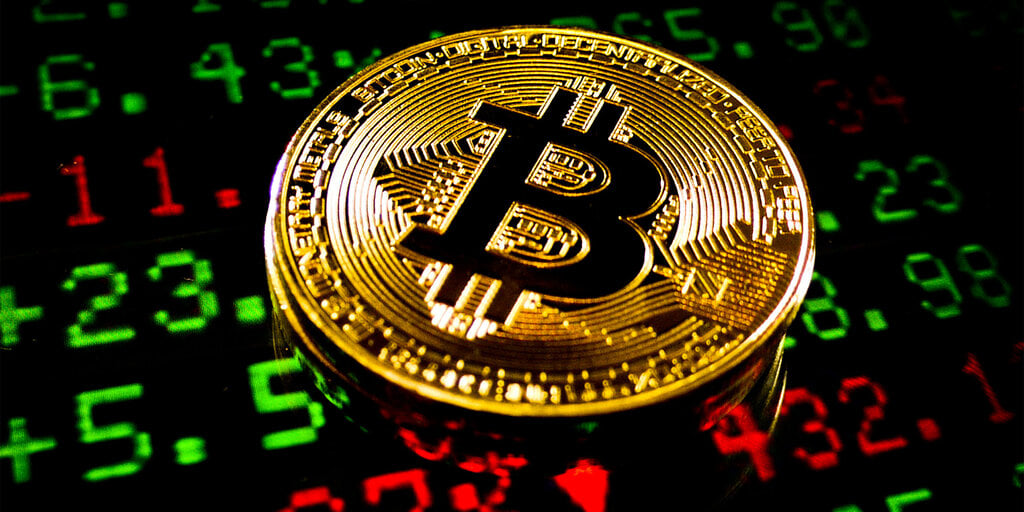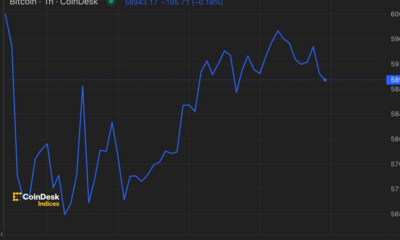Bitcoin
Trump proposes national cryptocurrency stockpile to send Bitcoin ‘to the moon’

Trump vows to fire SEC chairman at Nashville Bitcoin conference
Applause at Bitcoin conference follows Donald Trump’s vow to fire SEC Chairman Glen Gensler
Former President Donald Trump has outlined his plan to make the United States the “cryptocurrency capital of the planet and the world’s Bitcoin superpower,” promising to establish the country’s first strategic Bitcoin stockpile if elected.
Trump is the first presidential candidate from a major political party to make Bitcoin and cryptocurrency a campaign issue, and the first American president to speak at a Bitcoin event, addressing an enthusiastic and packed audience. crowd at Bitcoin 2024 conference at Music City Center in Nashvilletwo weeks after surviving an assassination attempt.
“If cryptocurrency is going to define the future, I want it to be mined, minted and made in the USA,” Trump said. “If Bitcoin goes to the moon, as they say, ‘goes to the moon,’ I want America to be the nation that leads the way.”
A cornerstone of his plan to make this happen is the first Strategic National Bitcoin Stockpile, seeded with about 210,000 Bitcoins ― valued at about $13 billion ― that the federal government has already obtained through lawful seizures from law enforcement agencies. The U.S. government is among the largest holders of Bitcoin in the world.
“For too long, our government has violated a cardinal rule that every Bitcoiner knows by heart: Never sell your Bitcoin,” he said. “If I am elected, it will be the policy of my administration for the United States of America to hold 100% of all Bitcoin that the U.S. government currently holds or acquires.”
While Trump has expressed skepticism about Bitcoin in the past, going as far as calling it “a disaster waiting to happen,” on Saturday he vowed to be a “pro-Bitcoin president.”
Trump took the stage 57 minutes after he was scheduled to speak — and about three hours after access to the room was cut off by the Secret Service. Despite the delay — during which rumors spread of a surprise appearance by Space X CEO Elon Musk, whose plane was flying over Nashville at the time — the crowd remained enthusiastic about the former president.
During his 51-minute speech on Saturday, Trump praised innovation from industry leaders as critical to the nation’s future, comparing the cryptocurrency industry to the steel industry of 100 years ago and calling the crowd “modern-day Edisons and Wright brothers and Carnegies and Henry Fords.”
“America always plants our flag on the next frontier and boldly moves forward,” Trump said. “You are building America’s future with your own intelligence, your own courage and your own skin in the game.”
Trump has made moves in recent months that signal his reversal of policy on cryptocurrencies goes beyond rhetoric. Earlier this year, Trump’s presidential campaign became the first to accept donations in Bitcoin and cryptocurrencies. Since doing so in May, Trump announced on Saturday that his camp has raised $25 million in Bitcoin and other cryptocurrencies. He also picked a running mate in Ohio Sen. J.D. Vance, who has been a vocal supporter of cryptocurrencies and revealed in 2022 that he holds Bitcoin.
While in Nashville, Trump is reportedly holding a campaign fundraiser, where top tickets have sold for as much as $844,600 per person — the maximum contribution amount to his joint fundraising committee, the Trump 47 Committee. Photo opportunities with Trump were available for $60,000 per person and $100,000 per couple.
Trump is scheduled to speak at a rally in Minnesota on Saturday night with Vance, aiming to make the historically blue state competitive.
Promises to fire SEC chairman and commute Ross Ulbricht’s sentence
Trump made several promises to the world’s top Bitcoiners on Saturday, including appointing a cryptocurrency-friendly council to draft regulations for the industry, increasing U.S. energy production to support Bitcoin mining, commuting Ross Ulbricht’s sentence and “firing” Gary Gensler from the U.S. Securities and Exchange Commission.
Trump has promised to appoint a Bitcoin and cryptocurrency advisory board on his first day in office and task the group with “designing transparent regulatory guidance for the benefit of the entire industry” within 100 days.
“We will have regulations, but for now the rules will be written by people who love their industry, not by people who hate their industry,” he said.
He unveiled his plan to “harness American energy in every form” to bring the lowest cost energy and electricity in the world, which he said would make America “the undisputed mining powerhouse of the world.”
“Bitcoin and cryptocurrencies will grow our economy, cement American financial dominance, and strengthen our entire country long into the future,” he said.
Trump also reiterated his promise to commute the sentence of Ross Ulbricht — the founder of the darknet marketplace Silk Road that facilitated the sale of narcotics, who is currently serving a life sentence — prompting chants of “Free Ross! Free Ross!” from the crowd. Trump also said he would end the U.S. Justice Department’s Operation Choke Point, an investigative effort to investigate banks, firearms dealers and payday loan lenders believed to be at high risk of fraud.
But the biggest cheers of the speech came when Trump promised to “fire” U.S. Securities and Exchange Commission Chairman Gary Gensler — an announcement that brought the audience to its feet. Gensler has been hostile to the cryptocurrency industry.
“I didn’t know he was so unpopular,” Trump said. “Let me say it again. On day one, I will fire Gary Gensler.”
The crowd roared again and broke into chants of “Trump! Trump! Trump!”
“I will nominate a new SEC chairman who believes America should build the future, not block the future, which is what happened. And Kamala Harris wants to make him Treasury Secretary.”
Ending Biden’s “Anti-Crypto Crusade”
He vowed to stop what he called the Biden Harris administration’s “anti-crypto crusade” and oppose efforts to establish a central bank digital currency – to cheers from the crowd.
Unlike him independent opposition figure Robert F. Kennedy Jr., who spoke at the conference on FridayTrump has not promised to direct the US Treasury to strategically buy Bitcoin to help stabilize the US dollar.
“The moment I take office, the persecution stops and the weaponization of your industry stops, and as long as I am in the Oval Office,” Trump said.
“You’re going to be very happy with me,” Trump said, drawing a laugh. “You’re going to be very happy.”
He celebrated President Joe Biden’s withdrawal from the race, but criticized Vice President Kamala Harris as “a radical left lunatic” who is “against cryptocurrencies… very much against them.”
“For three and a half years, the current government has waged a war on cryptocurrencies and Bitcoin like no one has ever seen before,” he said.
He encouraged the crowd to get out and vote, warning that if he loses the election, “this country could be over,” calling his political opponents “totalitarians hell-bent on destroying cryptocurrencies.”
“You have the SEC, you know what they’re doing: obliterating Bitcoin. The reason couldn’t be clearer, because Bitcoin represents freedom, sovereignty, and independence from government coercion.”
Trump criticized the Biden administration’s spending, blaming “trillions of dollars of ridiculous waste approved by our opponents” that he said resulted in “the same inflationary disaster that Bitcoiners have always predicted.”
“The bitcoiners understood inflation frankly better than anyone else ― if they had only listened,” Trump said. “20-30% of the value of every dollar was quickly wiped out. The savings of millions of Americans were quickly destroyed. It’s a stealth tax. I called it the Biden tax, now I call it the Harris tax. Inflation is a 50% tax on the people. This is a human tragedy.”
He has promised, if re-elected, to cut regulations, combat inflation and make permanent the tax cuts he passed during his first term.
“Those who say Bitcoin is a threat to the dollar are exactly wrong: Bitcoin is not threatening the dollar,” he said. “The behavior of the current US administration is actually threatening the dollar.”
Tennessee Senator Marsha Blackburn and Former Presidential Candidate Vivek Ramaswamy Promote Bitcoin
Several Tennessee officials attended or spoke at the Bitcoin conference and expressed support for the cryptocurrency’s integration into the mainstream economy.
U.S. Sen. Marsha Blackburn, R-Brentwood, spoke on a panel alongside former presidential candidate and entrepreneur Vivek Ramaswamy on Saturday night and shared support for making Bitcoin a 401(k) investment option for federal employees.
Ramaswamy said that Bitcoin should remain apolitical and that political support for Bitcoin comes from the desire to do what is best for the country.
“Capitalism is neutral. Capitalism is what unites us despite our partisan differences,” he said.
Blackburn emphasized his support for the industry and ensuring that people have the personal freedom to invest in Bitcoin.
“The federal government should not be interfering in your transactional life,” Blackburn said.
Blackburn also held a “Biscuits and Bitcoin” campaign event ahead of the conference on Saturday morning with Ramaswamy, former acting Director of National Intelligence Richard Grenell and Wyoming Sen. Cynthia Lummis on Saturday, which was attended by Tennessee Attorney General Jonathan Skrmetti and Knox County Mayor Glenn Jacobs.
Later on Saturday, Lummis announced that she will file legislation to create a strategic Bitcoin reserve to establish the U.S. dollar as the world’s reserve currency. Earlier this month, Blackburn’s campaign announced that it would accept donations contributed in Bitcoin and cryptocurrency.
— Staff writer Hadley Hitson contributed to this report.
Vivian Jones covers state government and politics for The Tennessean. Reach her at vjones@tennessean or at X at @Vivian_E_Jones.
Bitcoin
Bitcoin (BTC) Price Drops Below $65K After FOMC as Middle East Tensions Rise

Cryptocurrencies fell sharply on Wednesday as rising geopolitical risks captivated investors’ attention following the conclusion of the Federal Reserve’s July meeting.
Bitcoin (BTC) fell to $64,500 from around $66,500, where it traded following Federal Reserve Chairman Jerome Powell’s press conference and is down more than 2% in the past 24 hours. Major altcoins including ether (ETH)sunbathing (SUN)Avalanche AVAX (AVAX) and Cardano (ADA) also fell, while Ripple’s XRP saved some of its early gains today. The broad cryptocurrency market benchmark CoinDesk 20 Index was 0.8% lower than 24 hours ago.
The liquidation happened when the New York Times reported that Iran’s leaders have ordered retaliation against Israel over the killing of Hamas leader Ismail Haniyeh in Tehran, raising the risk of a wider conflict in the region.
Earlier today, the Fed left benchmark interest rates unchanged and gave little indication that a widely expected rate cut in September is a given. The Fed’s Powell said that while no decision has been made on a September cut, the “broad sense is that we are getting closer” to cutting rates.
While digital assets suffered losses, most traditional asset classes rose higher during the day. U.S. 10-year bond yields fell 10 basis points, while gold rose 1.5% to $2,450, slightly below its record highs, and WTI crude oil prices rose 5%. Stocks also rallied during the day, with the tech-heavy Nasdaq 100 index rebounding 3% and the S&P 500 closing the session 2.2% higher, led by 12% gains in chipmaker giant Nvidia (NVDA).
The different performances across asset classes could be due to traders’ positioning ahead of the Fed meeting, Zach Pandl, head of research at Grayscale, said in an emailed note.
“Equities may have been slightly underutilized after the recent dip, while bitcoin is coming off a strong period with solid inflows, while gold has recovered after a period of weakness,” he said.
“Overall, the combination of Fed rate cuts, bipartisan focus on cryptocurrency policy issues, and the prospect of a second Trump administration that could advocate for a weaker U.S. dollar should be viewed as very positive for bitcoin,” he concluded.
UPDATE (July 31, 2024, 21:30 UTC): Adds grayscale comments.
Bitcoin
No, Bitcoin Will Not Solve Our National Debt

Wyoming Republican Senator Cynthia Lummis speaks at the Bitcoin 2024 conference in … [+] Nashville, Tennessee, U.S., on Saturday, July 27, 2024. Former U.S. President Donald Trump said he would fire the chairman of the Securities and Exchange Commission and pick crypto-friendly regulators if he returns to the White House in a bid to woo virtual currency enthusiasts and capitalize on the industry’s growing influence in the political arena. Photographer: Brett Carlsen/Bloomberg
© 2024 Bloomberg Finance LP
At a Bitcoin conference last weekend, Senator Cynthia Lummis (R-Wyo.) announced future legislation that would direct the Treasury to purchase 1 million Bitcoin, or roughly 5% of the global supply, over five years (which would cost between $60 billion and $70 billion at today’s prices). Lummis claimed that the federal government would be “debt-free because of Bitcoin” if his proposal were to pass, because these Bitcoins could be sold by the federal government at a profit after 20 years. Unfortunately, there are mathematical and conceptual problems that prevent such an approach from solving the federal government’s budget problems.
Let’s start with the math: US National Debt Today stands at nearly $28 trillion (or $35 trillion if you include the “intragovernmental debt” that the general fund owes to other internal government accounting entities, such as the Social Security and Medicare trust funds). This year alone, the federal government spent about $2 trillion more than it took in in revenue, which had to be covered by borrowing money that adds to our national debt.
In comparison, the total market capitalization of Bitcoin today (which is the total number of Bitcoins in existence multiplied by their current market price) is only about $1.3 trillion — and that’s with Bitcoin’s current price near its all-time high. If all the Bitcoin in the world isn’t worth enough to cover a single year’s budget deficit, there’s no way buying 5% of it could plausibly stem the growth of, let alone pay off, our national debt. For the math to work, Bitcoin’s market cap would have to reach a level that is a multiple of the annual economic output of the entire planet (the International Monetary Fund current estimates the sum of each country’s gross domestic product is less than US$110 trillion).
But beyond the math, there are serious conceptual problems with Lummis’s proposal as a partial solution. When the government acquires an asset, it is typically reallocating rather than creating wealth. As the government buys some of the existing supply of Bitcoin, it would reduce the remaining supply available for others to buy on the market. If private demand for Bitcoin remains constant, the result would be an increase in the price of one Bitcoin. The beneficiaries of this transaction would be the current owners of Bitcoin (one of whom is Senator Lummis herself), because they would be in possession of an asset that can be sold at a higher price than the price at which it was originally purchased.
The increase in Bitcoin’s price, and thus the financial benefit to current holders, is likely to be even greater because, rather than remaining constant, private demand would increase as previously cautious investors view the U.S. government’s investment as an indicator of the digital asset’s legitimacy. These higher prices would not only increase demand for Bitcoin, but could also encourage Bitcoin “miners” to increase supply. Bitcoin mining is a extremely energy intensive process that relies on advanced graphics processing units (GPUs). If Bitcoin mining increases demand for GPUs, the GPUs themselves will become more expensive, as they did in 2020. In turn, every activity that depends on GPUs — from video editing to gaming — will also become more expensive.
Perhaps most alarmingly, a boom in Bitcoin mining threatens to stifle promising developments in artificial intelligence (AI). As other Forbes contributors point out, he wroteAI has the potential to revolutionize our economy and boost the productivity of our workforce in countless ways that would increase real wealth for Americans of all socioeconomic backgrounds. But AI also relies on advanced GPUs to function, of which there are already there is not enough supply to meet demand. It would be a profound failure of federal policy to make AI advances more costly to achieve by encouraging people to spend the resources needed to generate digital tokens. Furthermore, even if federal government Bitcoin purchases do not lead to an increase in Bitcoin mining, there are still other ways in which rising Bitcoin prices would displace productive economic investment — but rather than delve into them here, I recommend reading this great 2022 article by Josh Barro about the subject.
For these and other reasons, the federal government should not take any action to push the price of Bitcoin — or any other cryptocurrency, for that matter — above the level set by the free market. If policymakers believe that prices will continue to rise anyway and want to capture some of that value for deficit reduction, there are much better mechanisms for doing so. For example, a capital gains tax increase could aim to capture 5% of the gain on 100% of Bitcoin rather than capturing 100% of the gain on 5% of Bitcoin, as the Lummis proposal would seek to do. In addition to avoiding the market-distorting effects of the Lummis proposal, this approach has the added benefit of not leaving taxpayers holding the bag if the value of Bitcoin plummets, as then many other cryptocurrencies have done.
When it comes to dealing with our national debt, there is no substitute for cutting spending and/or raising taxes. There are no quick fixes here — policymakers must accept tradeoffs and make hard choices about how to allocate limited resources. Fortunately, my team at the Progressive Policy Institute recently published a serious package of proposals that deals with these tradeoffs to put the federal budget on a path to balance within 20 years. Even adopting half of our recommended savings would allow policymakers to keep debt from growing faster than our economy, which is what most economists consider to be the measure of fiscal sustainability. And ours is just one framework: six other think tanks published their own plans to stabilize the debt last week (and notably, none of them proposed spending up to $70 billion of taxpayer funds on Bitcoin).
To Senator Lummis’s credit, she has also supported efforts to promote serious solutions like these in the past. As a member of the U.S. House of Representatives in 2012, Lummis was one of only 38 members who resisted partisan pressure and voted in favor of a congressional budget resolution based on the debt stabilization recommendations of the bipartisan Simpson-Bowles Fiscal Commission. More recently, Lummis was one of nine senators to cosponsor a bill that would establish another bipartisan fiscal commission to generate an updated package of recommendations to stabilize the national debt. It would be a great service to the nation if Senator Lummis would put all her energy into advancing these and other serious efforts to align revenues and spending rather than distracting them with alternative schemes that would merely enrich cryptocurrency investors at the expense of the taxpayer.
Bitcoin
Bitcoin Falls as ETF Flows Reverse, Mt. Gox Moves Billions

In a week of drastic fluctuations, the price of Bitcoin (BTC) has retreated from its highs and is currently trading at US$66,250, down 0.9% in European trading.
This volatility comes on the heels of a significant surge above $70,000 earlier in the week, fueled by former President Donald Trump’s ambitious cryptocurrency plans announced in a Bitcoin Conference in Nashville.
Trump’s announcement to fire Securities and Exchange Commission Chairman Gary Gensler and establish a strategic Bitcoin reserve if elected president has temporarily sent the cryptocurrency market into a frenzy.
However, the excitement was short-lived as a series of events unfolded which caused investor sentiment to sour.
A significant sell-off of about 8% was triggered when the US Marshals Service moved $2 billion in Bitcoin for new wallets.
This move has reignited fears of a potential large-scale liquidation, compounded by lingering concerns over a possible Bitcoin liquidation from Mt. Gox. Early this morning, Mt. Gox administrator transferred US$2.2 billion value of your BTC assets in a new wallet.
Meanwhile, the US Bitcoin ETF spot market is showing signs of fluctuation, according to data from SoSo Value. On July 30, Bitcoin spot funds experienced their first net outflow in five days, totaling $18.3 million.
The Grayscale Bitcoin Trust (GBTC) saw outflows of $73.6 million, while the BlackRock iShares Bitcoin Trust (IBIT) attracted $74.9 million in inflows. But outflows from other funds left the category in the red at the end of Tuesday’s trading session. The total net asset value of spot Bitcoin ETFs currently stands at a substantial $58.5 billion.
In other crypto news, Ripple (XRP) is up 8.6% in the past 24 hours, hitting over 64 cents – its highest point since March 25, according to CoinGecko. data.
This rally comes amid a scheduled token unlock and growing optimism around a potential deal in the long-running SEC vs. Ripple lawsuit.
The crypto community is closely watching the SEC’s actions, particularly its intention to amend its complaint against Binance regarding “Third-Party Cryptocurrency Securities,” which some interpret as a positive sign for Ripple.
On a market analysis noteSingapore-based cryptocurrency trading desk QCP Capital wrote that while election headlines continue to dominate, several crucial macroeconomic events loom on the horizon.
“Election headlines will continue to be a key focus, but several key macroeconomic events are also on the horizon. Key events starting with the FOMC meeting on Wednesday, megacap tech earnings (Apple, Amazon, Meta) throughout the week, and unemployment data on Friday,” QCP Capital wrote.
Edited by Stacy Elliott.
Bitcoin
1 Top Cryptocurrency That Could Surge Over 4,300%, According to This Wall Street Firm

This bold prediction that Bitcoin will hit $2.9 million by 2050 could redefine your investment strategy.
In a groundbreaking report, VanEck, a leading investment management firm, has set the stage for an extraordinary prediction about Bitcoin‘s (BTC -2.63%) in the future. According to their analysis, Bitcoin could potentially reach a staggering $2.9 million by 2050, marking an astronomical increase of over 4,300% from its current price.
This bold prediction is more than just a headline-grabbing attempt. The report is packed with information across its 20+ pages, and includes plenty of evidence and hypotheses to support its claims. Luckily, I read the whole thing, so you don’t have to. In this article, we’ll explore the key elements of VanEck’s report, deciphering why Bitcoin’s value could skyrocket to such heights and what it means for investors and the financial world at large.
Image source: Getty Images.
Unpacking the VanEck Report
VanEck’s analysis outlines three scenarios for predicting Bitcoin’s future value: the bearish case, the base case, and the bullish case. Each scenario provides a different perspective on how Bitcoin may evolve based on various economic and technological factors, and of course, where its price may be headed.
To arrive at these conclusions, VanEck’s valuation model relies on a combination of historical data, current market trends, and future financial developments. This comprehensive approach aims to assess Bitcoin’s potential as a medium of exchange and reserve asset. With that out of the way, let’s move on to the scenarios.
Bear scenario
In the pessimistic case, Bitcoin’s value is expected to remain relatively stagnant, reflecting limited growth due to regulatory hurdles, technological limitations, or broader economic challenges.
This scenario assumes that Bitcoin will not achieve widespread adoption and will face significant competitive threats from other digital currencies or innovations. If this is the path Bitcoin takes, VanEck predicts that Bitcoin will only reach $130,314 by 2050. This equates to a measly 2.6% compound annual growth rate (CAGR).
Base scenario
The base case presents a more balanced view, where Bitcoin’s value is influenced by moderate adoption and integration into the existing financial system. However, even though it is called the base case, it is still extremely bullish.
This analysis predicts that Bitcoin will reach a price of $2,910,345 and solidify itself as a viable digital asset, resulting in a stronger CAGR of close to 15.7%. Driving this adoption are a multitude of factors, such as rising government debt around the world, reduced use of fiat currenciesbetter technology that makes Bitcoin faster and cheaper to use, and the possibility of Bitcoin becoming the world’s reserve currency.
Bullish scenario
The bullish scenario is the most optimistic, predicting that Bitcoin’s value could reach a staggering $52,386,207 by 2050. Here, Bitcoin’s CAGR rises to 29.3%.
This extreme growth projection is based on Bitcoin achieving widespread adoption as a medium of exchange and a reserve asset. It considers advances in blockchain technology, significant macroeconomic changes, and increased institutional investment. In short, this scenario basically assumes that the world will undergo hyper-Bitcoinization very quickly.
How Bitcoin Could Reach $2.9 Million
While the bear and bull scenarios are unlikely outliers on either end of the spectrum, it’s worth examining the reasoning behind VanEck’s base result in greater detail. This intermediate target strikes a valuable middle ground and does a good job of capturing what makes Bitcoin so unique.
The first catalyst that could send Bitcoin to nearly $3 million is increased adoption as a medium of exchange. As the world and its financial system become more digitized, there is a clear path where Bitcoin could gain traction as a popular medium of exchange. The decentralized nature of the cryptocurrency, coupled with its growing acceptance among merchants and consumers, supports its potential to become a mainstream payment method. If Bitcoin’s use as a transactional currency becomes widespread, VanEck suggests that its value could appreciate significantly.
At a more granular level, technological advancements are critical drivers of Bitcoin’s future valuation. For most of Bitcoin’s existence, its blockchain was more than capable of handling transactions cost-effectively. However, as the years have passed and it has processed more transactions, there has been a need to find a method for Bitcoin to scale efficiently.
Fortunately, there are a number of solutions in development that attempt to make Bitcoin faster and cheaper to use, such as Lightning Network and layer 2 blockchains like Stacks (STX -3.26%). VanEck believes that if Bitcoin is able to scale properly, it will only bolster the cryptocurrency’s prospects following the base case trajectory.
Expanding a bit, VanEck posits that Bitcoin could become a global reserve asset, similar to gold, as institutional investors and nations seek a stable store of value in a turbulent economic landscape. As VanEck’s report outlines, the global financial world is currently in a state of flux.
The currencies of the most prosperous economies (the US, EU, Japan and the UK) are starting to be used less for international payments. Furthermore, these economies, which dominated for much of the last century, face a growing debt burden that could further erode the value of their currencies. VanEck’s report predicts that as this trend worsens, other nations will turn to Bitcoin due to its apolitical construction and robust fundamentals that prioritize value preservation. When all is said and done, Bitcoin could become the world’s global reserve currency, causing its price to soar as governments clamor for a share of its finite supply.
Last food for thought
VanEck’s prediction that Bitcoin could rise to over $2.9 million by 2050 represents a bold and optimistic outlook for the cryptocurrency. It may sound sensationalist, but keep in mind that virtually no one could have imagined that Bitcoin would rise from just a few cents to over $60,000 over the past 15 years.
However, as appealing as this may sound, a bit of restraint is in order. No one has a crystal ball, and while the outlook is promising, investors should carefully weigh the rewards against the risks and, more importantly, Approaching Bitcoin with a long-term perspective.
But for those who believe in its future potential, have an appetite for risk, and are comfortable holding for the long term, Bitcoin’s current value could represent an attractive entry point. See you in 2050.
-

 News1 year ago
News1 year agoBitcoin (BTC) price recovery faces test on non-farm payrolls
-

 Bitcoin12 months ago
Bitcoin12 months ago1 Top Cryptocurrency That Could Surge Over 4,300%, According to This Wall Street Firm
-

 Altcoins12 months ago
Altcoins12 months agoOn-chain data confirms whales are preparing for altcoin surge with increased buy orders
-

 Bitcoin12 months ago
Bitcoin12 months agoThe US government may start accumulating Bitcoin, but how and why?
-

 News1 year ago
News1 year agoNew ByBit Listings for 2024: 10 Potential Listings
-

 News1 year ago
News1 year ago11 Best Crypto TikTok Accounts & Influencers in 2024
-

 Altcoins1 year ago
Altcoins1 year agoMarket giants have taken action!
-

 News1 year ago
News1 year ago11 Best Shitcoins to Buy in 2024: The Full List
-

 Ethereum1 year ago
Ethereum1 year agoTop Meme Coins by Market Capitalization in 2024
-

 News1 year ago
News1 year ago1.08 Trillion SHIBs Dumped on Major Crypto Exchange, What’s Going On?
-

 News1 year ago
News1 year ago19 Best Crypto Games to Play in 2024
-

 Altcoins1 year ago
Altcoins1 year agoAltcoin Recommended by Crypto Expert for Today’s Portfolio

















